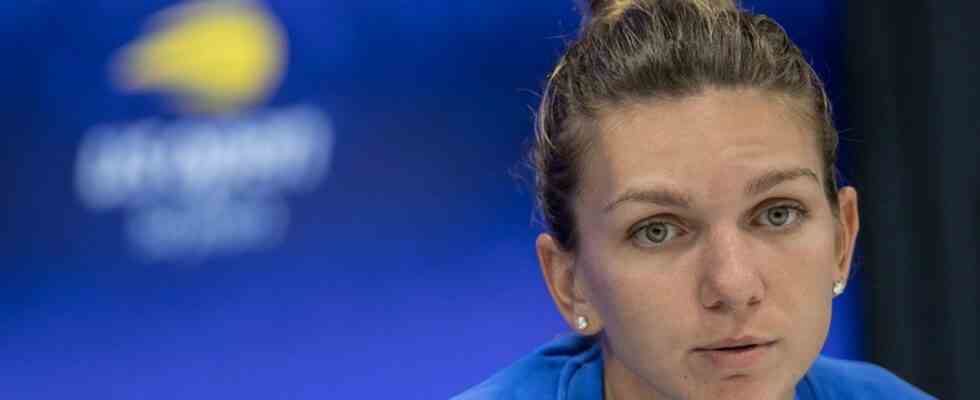A relatively short email shook tennis on Friday afternoon. At 3:34 p.m., the International Tennis Integrity Agency (ITIA) wrote in a statement to the media that player Simona Halep had been given a “provisional suspension under the tennis anti-doping program” while she was participating in the US Open at the end of August , the last Grand Slam tournament of this season, the Romanian was found to be positive. The drug Roxadustat, which is said to help patients with chronic kidney failure, who suffer from anemia in particular, was detected in both the A sample and the B sample.
Since it stimulates the formation of red blood cells and increases the transport of oxygen in the body, the active ingredient has been known for several years as a possible doping agent and can also be proven. Unlike the illegal Epo used primarily in cycling, Roxadustat is not injected, but can be taken as a tablet. The first doper convicted of Roxadustat in 2015 was the walker Bertrand Moulinet, who admitted to taking it and was banned for four years. At the 2012 Olympic Games in London, the Frenchman finished eighth over the 20-kilometer distance.
Just minutes after the ITIA made the measure public, Halep took to social media. “Today begins the toughest match of my life: a fight for the truth,” she announced. “I was informed that I had tested positive for a substance called Roxadustat in an extremely low level, which was the biggest shock of my life. In my entire career, the idea of cheating never once crossed my mind because that Completely goes against all the values I was raised with.”
Halep has won two Grand Slam titles, in Paris and Wimbledon
Your positive finding has a great fall height because Halep is not just any professional. The now 31-year-old from Constanta on the Black Sea was number one in the world rankings for 64 weeks. She won two of the biggest tournaments in tennis with the titles at the French Open 2018 and Wimbledon 2019. Halep is also very popular among players and has countless fans worldwide – 1.7 million people alone follow the messages and pictures that she regularly publishes on her Instagram account. After her triumph at the All England Club, Halep was celebrated by 30,000 compatriots at the football stadium in Bucharest. She is a star at home, where, like in many other countries, football is by far the most popular sport.
In terms of dimensions, the case is similar to that of Maria Sharapova, even if she was an even more dazzling personality in tennis and for years earned tens of millions with advertising. The Russian, who won five Grand Slams, was initially banned for two years in 2016 for taking the cardiovascular drug Meldonium. After an appeal before the International Sports Court (Cas), the sentence was reduced to 15 months.
Since January 2016, taking meldonium, which promotes endurance and blood circulation, has been banned for professional athletes. Whether Halep, like Sharapova, who is no longer active and who recently gave birth, will take action against the judgment of the ITIA, which is the relevant organization for such cases in tennis, was left open for the time being. But she has already made it clear that she sees herself as a victim.
Only a few colleagues comment publicly on the case
In her statement, she wrote, also somewhat cryptically: “In this unfair situation I feel betrayed and irritated at the same time. I will fight to the end to prove that I never knowingly took a prohibited substance.” She did not specify who or what she felt betrayed by. She closed her letter with pathetic words: “It’s not about titles or money. It’s about honor and the love for tennis that I’ve developed over the past 25 years”. Her attitude was not surprising. It is often taken by elite athletes who have been convicted of doping.
The reactions in the tennis industry were very cautious and wait-and-see. Patrick Mouratoglou, her coach, who built up a renowned academy in Nice, wrote only briefly on the Internet that he supports Halep “100 percent in this fight”. Only a few players conveyed their belief in a happy ending for Halep, such as France’s Alizé Cornet and Romania’s Sorana Cirstea. As the ITIA wrote, Halep himself found out about the positive sample on October 7th. At that point, she had already ended her season, which had more downs than ups for her. She won two tournaments (Melbourne, Toronto) and reached the semi-finals at Wimbledon. At the French Open in Paris, she suffered a panic attack during a match. Privately, their marriage broke up just a year after the wedding.
On September 15, after the US Open, Halep announced that she would undergo a long-needed nose job to improve her breathing and not return to the WTA Tour in 2022. She survived the surgery well, but it’s now more unclear than ever when she’ll be back playing tennis. It is now up to Halep to prove his own innocence, which should be difficult. The last match of the current number nine in the world rankings remains the then surprising first round defeat in New York against the Ukrainian Darija Snihur.

